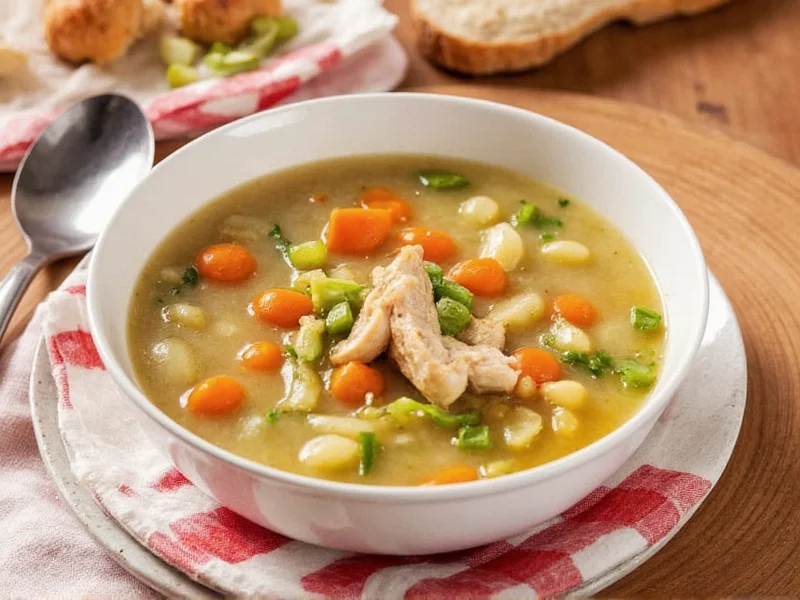The Ultimate Guide to Perfect Chicken Breast Soup
Creating exceptional chicken breast soup requires understanding why this particular cut behaves differently in liquid compared to thighs or wings. Chicken breasts contain less fat and connective tissue, making them prone to drying out if improperly cooked. The secret lies in controlled poaching temperatures and strategic ingredient sequencing that protects the delicate meat while building complex flavors.
Why Chicken Breast Works Best for Certain Soups
While traditional chicken soup often uses whole chickens or mixed cuts, chicken breast soup serves specific culinary purposes. Its mild flavor profile makes it ideal for delicate broths where you want the chicken taste to complement rather than dominate. Nutritionally, a 3-ounce serving provides approximately 26 grams of protein with only 3 grams of fat, making it superior for health-focused meal planning compared to dark meat alternatives.
Essential Ingredients Checklist
Selecting quality components determines your soup's success. For authentic chicken breast soup that avoids blandness:
| Ingredient Category | Recommended Choices | Avoid |
|---|---|---|
| Chicken | Fresh boneless, skinless breasts (1.5 lbs for 4 servings) | Pre-cooked or frozen breasts with additives |
| Broth | Low-sodium chicken or vegetable broth | Regular sodium broth (causes oversalting) |
| Vegetables | Yellow onion, celery, carrots, leeks, garlic | Starchy vegetables like potatoes (muddies broth) |
| Herbs | Fresh thyme, parsley, bay leaves | Dried herbs (unless toasted first) |
Step-by-Step Preparation Method
Follow this professional technique for consistently tender chicken breast soup:
- Sweat aromatics first - Cook onions, celery, and carrots in olive oil over medium heat until softened (8-10 minutes) without browning
- Add liquid gradually - Pour in 4 cups broth while scraping browned bits from pan bottom
- Controlled poaching - Bring to gentle simmer (180°F/82°C), add chicken breasts, and maintain sub-simmer temperature
- Timing precision - Cook chicken 12-15 minutes until internal temperature reaches 165°F (74°C)
- Resting period - Remove chicken immediately and let rest 5 minutes before shredding
- Final assembly - Return shredded chicken to soup with fresh herbs 2 minutes before serving
Nutritional Profile and Health Benefits
A standard 1.5-cup serving of properly prepared chicken breast soup delivers remarkable nutritional value:
- Calories: 180-220 (significantly lower than thigh-based soups)
- Protein: 25-30g (50% of daily requirement)
- Sodium: 450-600mg (when using low-sodium broth)
- Vitamins: Rich in B6, niacin, and selenium
This healthy chicken breast soup recipe supports muscle maintenance, immune function, and hydration. The broth base provides electrolytes while the lean protein promotes satiety, making it ideal for weight management programs. Unlike cream-based soups, this preparation maintains a light texture perfect for convalescence or active lifestyles.
Popular Variations for Different Dietary Needs
Adapt your chicken breast soup for specific preferences while maintaining tenderness:
- Asian-inspired version: Add ginger, lemongrass, and fish sauce; finish with bok choy and cilantro
- Creamy adaptation: Stir in 1/4 cup coconut milk at the end (not during chicken cooking)
- Low-carb option: Replace carrots with radishes and add chopped kale
- Meal prep friendly: Undercook vegetables slightly for better reheating results
Troubleshooting Common Problems
Even experienced cooks encounter issues with chicken breast soup. Here's how to fix them:
- Dry, stringy chicken: You likely boiled instead of poached. Maintain liquid temperature below 185°F (85°C)
- Bland broth: Toast vegetables longer before adding liquid; use mushroom trimmings for umami
- Cloudy appearance: Avoid vigorous boiling; strain through cheesecloth if needed
- Overpowering herb taste: Add delicate herbs like parsley only in the last 2 minutes
Storage and Reheating Guidelines
Chicken breast soup maintains quality exceptionally well when stored properly. Cool completely before transferring to airtight containers. Refrigerate for up to 4 days or freeze for 3 months. When reheating, add a splash of broth or water to compensate for liquid absorption during storage. Never microwave chicken breast soup on high power—use 50% power in 2-minute intervals to prevent rubberiness.
How do you prevent chicken breast from drying out in soup?
Remove chicken breasts from the broth as soon as they reach 165°F (74°C) internal temperature, then let them rest for 5 minutes before shredding. Maintain liquid temperature below a gentle simmer (180-185°F) during cooking—boiling causes proteins to contract and expel moisture.
Can you use frozen chicken breasts for soup?
Yes, but with adjustments. Increase cooking time by 5-7 minutes and add 1/4 teaspoon extra salt to compensate for frozen moisture. Never add frozen chicken directly to boiling liquid—start in cold or warm broth to prevent surface toughness while the center thaws.
What vegetables work best in chicken breast soup?
Classic mirepoix (onion, celery, carrots) provides ideal flavor foundation. For delicate chicken breast soup, add tender vegetables like leeks and fennel in the last 10 minutes. Avoid starchy vegetables like potatoes which cloud the broth. Fresh herbs should be added only during the final 2 minutes of cooking.
How long does homemade chicken breast soup last?
Properly stored in airtight containers, chicken breast soup remains fresh for 3-4 days in the refrigerator. For longer storage, freeze in portion-sized containers for up to 3 months. The lean nature of chicken breast means it reheats better than dark meat soups—add a splash of broth when reheating to maintain moisture.
Is chicken breast soup good for weight loss?
Yes, when prepared properly. A 1.5-cup serving contains approximately 200 calories with 25g of protein, creating high satiety with moderate calories. The key is avoiding heavy creams or excessive oils. This low calorie chicken breast soup provides sustained energy without spiking blood sugar, making it ideal for balanced meal planning.











 浙公网安备
33010002000092号
浙公网安备
33010002000092号 浙B2-20120091-4
浙B2-20120091-4